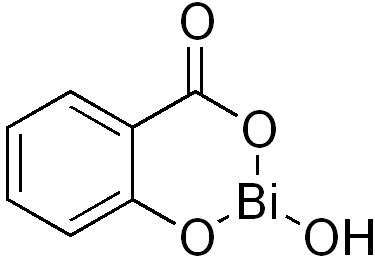Trade names Pepto-Bismol Routes ofadministration Oral | MedlinePlus a607040 ATC code none | |
 | ||
AHFS/Drugs.com Multum Consumer Information Legal status UK: P (Pharmacy medicines)US: OTC | ||
Bismuth subsalicylate, sold under the brand name Pepto-Bismol, is an antacid medication used to treat temporary discomforts of the stomach and gastrointestinal tract, such as diarrhea, indigestion, heartburn and nausea. Commonly known as pink bismuth, it is also sometimes the active ingredient in Kaopectate.
Contents
Bismuth subsalicylate has the empirical chemical formula of C7H5BiO4, and it is a colloidal substance obtained by hydrolysis of bismuth salicylate (Bi{C6H4(OH)CO2}3). The actual structure is unknown and the formulation is only approximate. Recent evidence dictates that it is composed of a bismuth oxide core structure with salicylate ions attached to the surface. A model structure has recently been published having the composition Bi38O44{C6H4(OH)CO2}26.
Medical uses
As a derivative of salicylic acid, bismuth salicylate displays anti-inflammatory and bactericidal action. It also acts as an antacid.
Adverse effects
There are some adverse effects. It can cause a black tongue and black stools in some users of the drug, when it combines with trace amounts of sulfur in saliva and the colon to form bismuth sulfide. Bismuth sulfide is a highly insoluble black salt, and the discoloration seen is temporary and harmless.
Long-term use (greater than 6 weeks) may lead to accumulation and toxicity. Some of the risks of salicylism can apply to the use of bismuth subsalicylate.
Children should not take medication with bismuth subsalicylate while recovering from influenza or chicken pox, as epidemiologic evidence points to an association between the use of salicylate-containing medications during certain viral infections and the onset of Reye's syndrome. For the same reason, it is typically recommended that nursing mothers not use medication containing bismuth subsalicylate because small amounts of the medication are excreted in breast milk and pose a theoretical risk of Reye's syndrome to nursing children.
Salicylates are very toxic to cats, and thus bismuth subsalicylate should not be administered to cats.
Structure
Characterization of the properties of bismuth subsalicylate has been difficult due to its insolubility and its partial hydrolysis. Two crystal structures are observed, they are:
It is believed that the latter cluster gives rise to the former, leading researchers to believe that they may be extrapolated to form larger clusters. This may be the basis for bismuth subsalicylate's extreme insolubility.
The term "sub" in the chemical name refers to the high oxygen content in the molecule and the presence of Bi-O moieties. Other bismuth carboxylates have typically been trapped using chelating amines such as bipyridine. Attempts to do so with bismuth subsalicylate have typically led to a loss of the "sub" portion of the molecule.
Mechanism of action
Bismuth subsalicylate is used as an antacid and antidiarrheal, and to treat some other gastro-intestinal symptoms, such as nausea. The means by which this occurs is still not well documented. It is thought to be some combination of the following:
In vitro and in vivo data has shown that bismuth subsalicylate hydrolyzes in the gut to bismuth oxychloride and salicylic acid and less commonly bismuth hydroxide. In the stomach, this is likely an acid-catalyzed hydrolysis. The salicylic acid is absorbed and therapeutical concentrations of salicylic acid can be found in blood after bismuth subsalicylate administration. Bismuth oxychloride and bismuth hydroxide are both believed to have bactericidal effects, as is salicylic acid for enterotoxigenic E. coli a common cause of "traveler's diarrhea."
Organobismuth compounds have historically been used in growth media for selective isolation of microorganisms. Such salts have been shown to inhibit proliferation of Helicobacter pylori, other enteric bacteria, and some fungi.
Decomposition
Bismuth subsalicylate is the only active ingredient in an over-the-counter drug that can leave a shiny metal oxide slag behind after being completely burnt with a blow torch.
History
While bismuth salts were in use in Europe by the late 1700s, the combination of bismuth subsalicylate and zinc salts for astringency with salol (phenyl salicilate) appears to have begun in the US in the early 1900s as a remedy for life-threatening diarrhea in infants with cholera. At first sold directly to physicians, it was first marketed as Bismosal in 1918.
Pepto-Bismol began being sold in 1900 or 1901 by a doctor in New York. It was originally sold as a remedy for infant diarrhea by Norwich Pharmacal Company under the name "Bismosal: Mixture Cholera Infantum". It was renamed Pepto-Bismol in 1919. Norwich Eaton Pharmaceuticals was acquired by Procter and Gamble in 1982.
As of 1946, Canadian advertisements placed by Norwich show the product as Pepto-Besmol both in graphic and text.
Pepto-Bismol is an over-the-counter drug currently produced by the Procter & Gamble company in the United States, Canada and the United Kingdom. Pepto-Bismol is made in chewable tablets and swallowable caplets, but is best known for its original formula which is a thick liquid. This original formula is a medium pink color with a strong wintergreen or cherry flavor.
